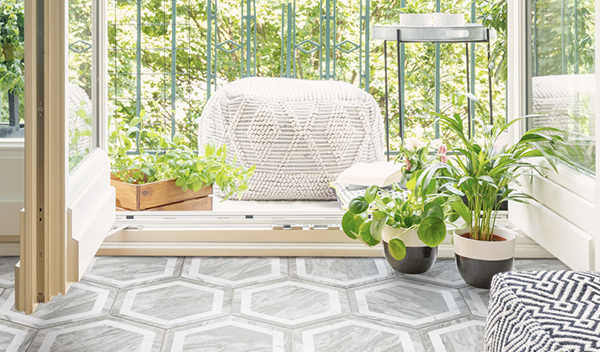Sustainable Spaces
Merola tiles redefine eco-friendly living by seamlessly merging beauty with sustainability. Navigate this section to appreciate the distinct blend of aesthetics and eco-consciousness that Merola tiles bring to the table.
As we navigate the 21st century, environmental consciousness and the quest for sustainable living continues to grow in importance. The focus has expanded from mere aesthetic appeal to environmental compatibility, and the materials we use in our homes or workplaces are at the forefront of this movement. Among the myriad of options available, ceramic-based materials stand out.
These tiles are appreciated not only for their artistic versatility and visual appeal, but also for their eco-friendliness. Ceramic and porcelain tiles are created from naturally occurring raw materials, including clays, sand, and glass. These tiles are kiln-fired at extremely high temperatures, which eliminates organic compounds and ensures strength and durability.
Natural material composition is just one of the reasons these tiles are considered an environmentally friendly choice. Let’s explore some other key factors that make ceramic and porcelain tiles the shining stars of sustainability.
One of the lesser-known benefits of ceramic and porcelain tiles is their ability to lower energy consumption. The thermal mass properties of these tiles help maintain consistent indoor temperatures, reducing the need for artificial heating or cooling. A ventilated tile façade can decrease a building’s energy consumption by 20% to 30%.
Tiles can also reduce the “Heat Island Effect” by resisting heat absorption and maintaining a consistent temperature. This is particularly valuable in urban or high-heat areas where reducing the heat island effect is crucial. Using light-colored tiles instead of traditional paving materials can significantly lower an area’s heat absorption.
The material composition of ceramic and porcelain tiles makes them extremely easy to clean and maintain. Their hard, impervious surface prevents dirt, oils, and spills from being absorbed. They don’t require harsh or toxic chemicals to clean; soap and water are usually enough to handle any mess.
Ceramic and porcelain tiles are incredibly durable, often lasting as long as the buildings in which they’re installed. This longevity reduces the environmental impact associated with replacing other types of floor coverings that have shorter lifespans.
A study analyzing the life-cycle costs of various flooring options revealed ceramic tiles to be the most cost-effective. The study included initial installation costs, potential replacement costs, and maintenance expenses over the flooring’s entire life cycle. Surprisingly, all types of ceramic tiles cost less than $0.99 per square foot per year, outperforming other popular flooring choices.
Many tile factories are essentially closed-loop facilities, producing zero waste. Additionally, tiles can often be salvaged during major renovations and repurposed for new projects. Innovative designers are even repurposing old tile, reclaiming vintage colors and designs to use in new tile projects. Ceramic and porcelain tiles were extremely popular with Art Deco and Mid-Century designers, and the look and feel of both styles is experiencing a renaissance in today’s trending home and work décor.
Whether you’re planning a residential or commercial project, understanding the environmental impact of your materials is crucial. As we search for ways to create more sustainable and planet conscious environments for life and work, tiles stand out as an ideal solution. Ceramic and porcelain tiles offer a unique combination of beauty, durability, and environmental compatibility, making them an excellent choice for those aiming to balance aesthetic appeal with eco-friendly living.
Key Resources & Insights
How to Choose the Perfect Grout Color for Your Tile Project
Discover how selecting the ideal grout color can transform your tile project, making it the perfect finishing touch for any room.
Do You Love Spooky Season AND Gorgeous Tile?
Embrace spooky season with Merola Tile’s Metro Hex 1″ and Stella Lustre Midnight tiles. Combining geometric charm and iridescent drama, they create hauntingly beautiful spaces.
Fireplace Tile Inspiration for a Warm and Inviting Autumn
Bring a natural and earthy warmth to your fireplace, perfect for creating a cozy autumn ambiance.
Create a Rustic Farmhouse Kitchen Design with the Kings Wild Wood-Look Tile
The Kings Wild Collection is not just another tile; it’s a labor of love. This tile has the rich complexities of natural wood and captures that same charm but with all the benefits of modern porcelain.








